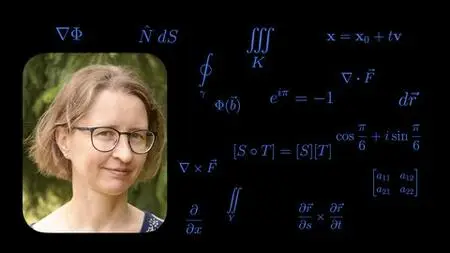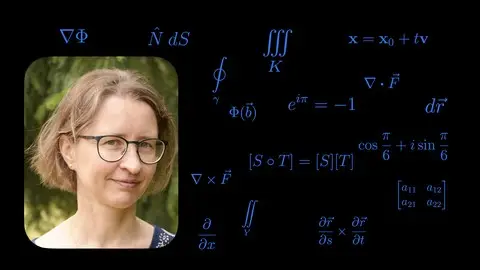Calculus 3 (multivariable calculus), part 1 of 2.
MP4 | Video: h264, 1280x720 | Audio: AAC, 44100 Hz
Language: English | Size: 3.21 GB | Duration: 47h 42m
MP4 | Video: h264, 1280x720 | Audio: AAC, 44100 Hz
Language: English | Size: 3.21 GB | Duration: 47h 42m
Towards and through the vector fields, part 1 of 2.
What you'll learn
How to solve problems in multivariable calculus (illustrated with more than 200 solved problems) and why these methods work.
Parameterize some curves (straight lines, circles, ellipses, graphs of functions of one variable, intersections of two surfaces).
Describe position, velocity, speed and acceleration; compute arc length of parametric curves; arc length parametrization.
Limits, continuity and differentiability for functions of several variables. Theory, geometric intuitions, and lots of problem solving.
Several variants of the Chain Rule, involving different kinds os functions. You will also learn how to apply these variants of the Chain Rule for problem solving.
Several variants of the Implicit Function Theorem, with various geometrical interpretations; problem solving.
Optimization of functions of several variables, both on open domains and on compact domains (Lagrange multipliers on the boundary, etc.).
Requirements
Calculus 1 and 2
Some linear algebra
Description
Calculus 3 / Multivariable Calculus. Part 1 of 2.
Towards and through the vector fields.
(Chapter numbers in Robert A. Adams, Christopher Essex: Calculus, a complete course. 8th or 9th edition.)
C0 Introduction to the course; preliminaries (Chapter 10: very briefly; most of the chapter belongs to prerequisites)
About the course
Analytical geometry in R^n (n = 2 and n = 3): points, position vectors, lines and planes, distance between points (Ch.10.1)
Conic sections (circle, ellipse, parabola, hyperbola) and quadric surfaces (spheres, cylinders, cones, ellipsoids, paraboloids etc) (Ch.10.5)
Topology in R^n: distance, open ball, neighbourhood, open and closed set, inner and outer point, boundary point. (Ch.10.1)
Coordinates: Cartesian, polar, cylindrical, spherical coordinates (Ch.10.6)
You will learn: to understand which geometrical objects are represented by simpler equations and inequalities in R^2 and R^3, determine whether a set is open or closed, if a point is an inner, outer or boundary point, determine the boundary points, describe points and other geometrical objects in the different coordinate systems.
C1 Vector-valued functions, parametric curves (Chapter 11: 11.1, 11.3)
Introduction to vector-valued functions
Some examples of parametrisation
Vector-valued calculus; curve: continuous, differentiable and smooth
Arc length
Arc length parametrisation
You will learn: Parametrise some curves (straight lines, circles, ellipses, graphs of functions of one variable); if r(t) = (x(t), y(t), z(t)) is a function describing a particle’s position in R^3 with respect to time t, describe position, velocity, speed and acceleration; compute arc length of parametric curves, arc length parametrisation.
C2 Functions of several variables; differentiability (Chapter 12)
Real-valued functions in multiple variables, domain, range, graph surface, level curves, level surfaces
You will learn: describe the domain and range of a function, Illustrate a function f(x,y) with a surface graph or with level curves.
Limit, continuity
You will learn: calculate limit values, determine if a function has limit value or is continuous at one point, use common sum-, product-, … rules for limits.
Partial derivative, tangent plane, normal line
You will learn: calculate first-order partial derivatives, compute scalar products (two formulas) and cross pro- duct, give formulas for normals and tangent planes; understand functions from R^n to R^m, gradients and Jacobians.
Higher partial derivates
You will learn: compute higher order partial derivatives, use Schwarz’ theorem. Solve and verify some simple PDE's.
Chain rule: different versions
You will learn: calculate the chain rule using dependency diagrams and matrix multiplication.
Linear approximation, linearisation, differentiability, differential
You will learn: determine if a function is differentiable in a point, linearisation of a real-valued function, use linearisation to derive an approximate value of a function, use the test for differentiability (continuous partial derivatives), and properties of differentiable functions.
Gradient, directional derivatives
You will learn: calculate the gradient, find the direction derivative in a certain direction, properties of gradients, understand the geometric interpretation of the directional derivative, give a formula for the tangent and normal lines to a level curve.
Implicit functions
You will learn: calculate the Jacobian determinant, derive partial derivatives with dependent and free variables of implicit functions.
Taylor's formula, Taylor's polynomial
You will learn: derive Taylor's polynomials and Taylor's formula. Understand quadratic forms and learn how to determine if they are positive definite, negative definite, or indefinite.
C3 Optimisation of functions of several variables (Chapter 13: 13.1–3)
Optimisation on open domains (critical points)
Optimisation on compact domains
Lagrange multipliers (optimisation with constraints)
You will learn: classify critical points: local max and min, saddle points; find max and min values for a given function and region; use Lagrange multipliers with one or more conditions.
Also make sure that you check with your professor what parts of the course you will need for your midterms. Such things vary from country to country, from university to university, and they can even vary from year to year at the same university.
A detailed description of the content of the course, with all the 255 videos and their titles, and with the texts of all the 216 problems solved during this course, is presented in the resource file "Outline_Calculus3.pdf" under video 1 ("Introduction to the course"). This content is also presented in video 1.
Who this course is for:
University and college engineering



